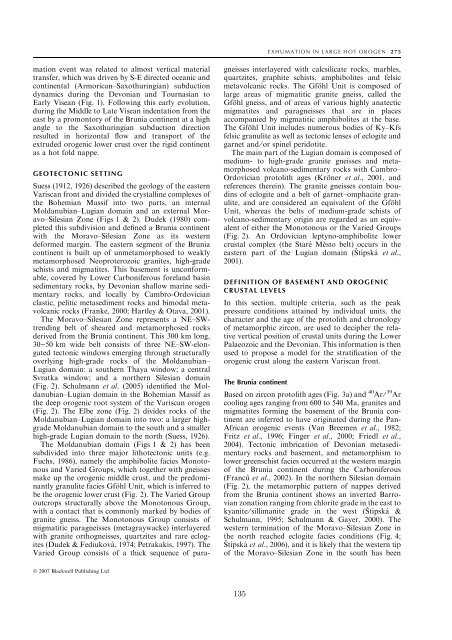Quantitative structural analyses and numerical modelling of ...
Quantitative structural analyses and numerical modelling of ...
Quantitative structural analyses and numerical modelling of ...
You also want an ePaper? Increase the reach of your titles
YUMPU automatically turns print PDFs into web optimized ePapers that Google loves.
EXHUMATION IN LARGE HOT OROGEN 275mation event was related to almost vertical materialtransfer, which was driven by S-E directed oceanic <strong>and</strong>continental (Armorican–Saxothuringian) subductiondynamics during the Devonian <strong>and</strong> Tournasian toEarly Visean (Fig. 1). Following this early evolution,during the Middle to Late Visean indentation from theeast by a promontory <strong>of</strong> the Brunia continent at a highangle to the Saxothuringian subduction directionresulted in horizontal flow <strong>and</strong> transport <strong>of</strong> theextruded orogenic lower crust over the rigid continentas a hot fold nappe.GEOTECTONIC SETTINGSuess (1912, 1926) described the geology <strong>of</strong> the easternVariscan front <strong>and</strong> divided the crystalline complexes <strong>of</strong>the Bohemian Massif into two parts, an internalMoldanubian–Lugian domain <strong>and</strong> an external Moravo–SilesianZone (Figs 1 & 2). Dudek (1980) completedthis subdivision <strong>and</strong> defined a Brunia continentwith the Moravo–Silesian Zone as its westerndeformed margin. The eastern segment <strong>of</strong> the Bruniacontinent is built up <strong>of</strong> unmetamorphosed to weaklymetamorphosed Neoproterozoic granites, high-gradeschists <strong>and</strong> migmatites. This basement is unconformable,covered by Lower Carboniferous forel<strong>and</strong> basinsedimentary rocks, by Devonian shallow marine sedimentaryrocks, <strong>and</strong> locally by Cambro-Ordovicianclastic, pelitic metasediment rocks <strong>and</strong> bimodal metavolcanicrocks (Franke, 2000; Hartley & Otava, 2001).The Moravo–Silesian Zone represents a NE–SWtrendingbelt <strong>of</strong> sheared <strong>and</strong> metamorphosed rocksderived from the Brunia continent. This 300 km long,30)50 km wide belt consists <strong>of</strong> three NE–SW-elongatedtectonic windows emerging through <strong>structural</strong>lyoverlying high-grade rocks <strong>of</strong> the Moldanubian–Lugian domain: a southern Thaya window; a centralSvratka window; <strong>and</strong> a northern Silesian domain(Fig. 2). Schulmann et al. (2005) identified the Moldanubian–Lugi<strong>and</strong>omain in the Bohemian Massif asthe deep orogenic root system <strong>of</strong> the Variscan orogen(Fig. 2). The Elbe zone (Fig. 2) divides rocks <strong>of</strong> theMoldanubian–Lugian domain into two: a larger highgradeMoldanubian domain to the south <strong>and</strong> a smallerhigh-grade Lugian domain to the north (Suess, 1926).The Moldanubian domain (Figs 1 & 2) has beensubdivided into three major lithotectonic units (e.g.Fuchs, 1986), namely the amphibolite facies Monotonous<strong>and</strong> Varied Groups, which together with gneissesmake up the orogenic middle crust, <strong>and</strong> the predominantlygranulite facies Gfo¨ hl Unit, which is inferred tobe the orogenic lower crust (Fig. 2). The Varied Groupoutcrops <strong>structural</strong>ly above the Monotonous Group,with a contact that is commonly marked by bodies <strong>of</strong>granite gneiss. The Monotonous Group consists <strong>of</strong>migmatitic paragneisses (metagraywacke) interlayeredwith granite orthogneisses, quartzites <strong>and</strong> rare eclogites(Dudek & Fediukova´ , 1974; Petrakakis, 1997). TheVaried Group consists <strong>of</strong> a thick sequence <strong>of</strong> paragneissesinterlayered with calcsilicate rocks, marbles,quartzites, graphite schists, amphibolites <strong>and</strong> felsicmetavolcanic rocks. The Gfo¨ hl Unit is composed <strong>of</strong>large areas <strong>of</strong> migmatitic granite gneiss, called theGfo¨ hl gneiss, <strong>and</strong> <strong>of</strong> areas <strong>of</strong> various highly anatecticmigmatites <strong>and</strong> paragneisses that are in placesaccompanied by migmatitic amphibolites at the base.The Gfo¨ hl Unit includes numerous bodies <strong>of</strong> Ky–Kfsfelsic granulite as well as tectonic lenses <strong>of</strong> eclogite <strong>and</strong>garnet <strong>and</strong> ⁄ or spinel peridotite.The main part <strong>of</strong> the Lugian domain is composed <strong>of</strong>medium- to high-grade granite gneisses <strong>and</strong> metamorphosedvolcano-sedimentary rocks with Cambro–Ordovician protolith ages (Kro¨ ner et al., 2001, <strong>and</strong>references therein). The granite gneisses contain boudins<strong>of</strong> eclogite <strong>and</strong> a belt <strong>of</strong> garnet–omphacite granulite,<strong>and</strong> are considered an equivalent <strong>of</strong> the Gfo¨ hlUnit, whereas the belts <strong>of</strong> medium-grade schists <strong>of</strong>volcano-sedimentary origin are regarded as an equivalent<strong>of</strong> either the Monotonous or the Varied Groups(Fig. 2). An Ordovician leptyno-amphibolite lowercrustal complex (the Stare´ Město belt) occurs in theeastern part <strong>of</strong> the Lugian domain (Sˇtı´ pska´ et al.,2001).DEFINITION OF BASEMENT AND OROGENICCRUSTAL LEVELSIn this section, multiple criteria, such as the peakpressure conditions attained by individual units, thecharacter <strong>and</strong> the age <strong>of</strong> the protolith <strong>and</strong> chronology<strong>of</strong> metamorphic zircon, are used to decipher the relativevertical position <strong>of</strong> crustal units during the LowerPalaeozoic <strong>and</strong> the Devonian. This information is thenused to propose a model for the stratification <strong>of</strong> theorogenic crust along the eastern Variscan front.The Brunia continentBased on zircon protolith ages (Fig. 3a) <strong>and</strong> 40 Ar ⁄ 39 Arcooling ages ranging from 600 to 540 Ma, granites <strong>and</strong>migmatites forming the basement <strong>of</strong> the Brunia continentare inferred to have originated during the Pan-African orogenic events (Van Breemen et al., 1982;Fritz et al., 1996; Finger et al., 2000; Friedl et al.,2004). Tectonic imbrication <strong>of</strong> Devonian metasedimentaryrocks <strong>and</strong> basement, <strong>and</strong> metamorphism tolower greenschist facies occurred at the western margin<strong>of</strong> the Brunia continent during the Carboniferous(Francu˚ et al., 2002). In the northern Silesian domain(Fig. 2), the metamorphic pattern <strong>of</strong> nappes derivedfrom the Brunia continent shows an inverted Barrovianzonation ranging from chlorite grade in the east tokyanite ⁄ sillimanite grade in the west (Sˇtı´ pska´ &Schulmann, 1995; Schulmann & Gayer, 2000). Thewestern termination <strong>of</strong> the Moravo–Silesian Zone inthe north reached eclogite facies conditions (Fig. 4;Sˇtı´ pska´ et al., 2006), <strong>and</strong> it is likely that the western tip<strong>of</strong> the Moravo–Silesian Zone in the south has beenÓ 2007 Blackwell Publishing Ltd135







